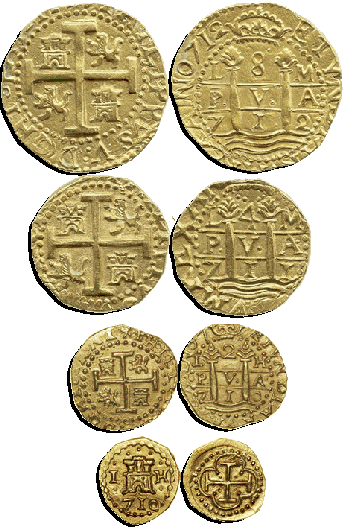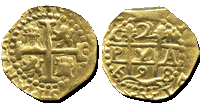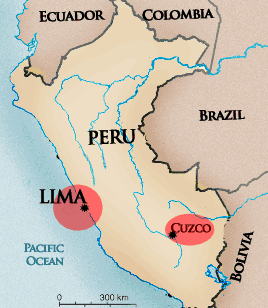
|
|
Lima, Peru, cobs choice set: 8 escudos 1712M, 4 escudos 1710M, 2 escudos 1710H and 1 escudo 1710H. From the 1715 Fleet.
|
For starters, the Peruvian gold-cob series is eminently collectible, with nearly all the years of 1696-1750 more or less available with time and patience, at least in the 8 escudos, as the smaller gold coins are less common overall (note also that we are excluding the unauthorized issues of 1659, which are somewhat conjectural). That is not to say that Peruvian gold cobs are common; in fact the opposite is the case, as generally these coins were shipped to Spain and melted.[2] Not surprisingly, much of the market supply of these coins comes from several different shipwreck finds, particularly the 1715 Fleet[3] but also the Loosdrecht (1719), the 1733 Fleet and the Luz (1752).[4] Type-collectors enjoy the fact that Peruvian gold cobs cover four reigns—Charles II, Philip V, Louis I and Ferdinand VI—while numerous die-varieties (overdates, legend lettering and interior ornamentation) present challenges for advanced collectors. Perhaps most important, the gold cobs of Peru have a unique design, which was not made at any other Old World or New World Spanish mint.
This masterful design reflects the fact that silver cobs in Peru were struck for well over 100 years before gold cobs, through periods of mint closure, fraud, scandal and redesign. By the time the Lima mint had begun to strike gold in 1696, it had already been decided that one side of each coin should show castles and lions within a cross on the obverse and a tic-tac-toe design consisting of mintmark, assayer, date and the PLVS VLTRA motto on the reverse. (The simpler 1 escudo bears only mintmark-assayer flanking and date below a castle on obverse and plain cross on reverse.) While the Peruvian engravers never achieved total consistency with the legends (also the quality of details declined steadily over the years), the basic inner design NEVER changed except for ornamentation. Why mess with success?
But it is the execution of this design that is remarkable in Peruvian gold cobs, for practically every specimen is well centered, with clear date and assayer and mintmark and usually with most of the characters in the legends at least partially visible, on a round flan of uniform thickness and consistent weight (albeit about an eighth of a gram below the standard of 27.064 grams). Compare this to the odd-shaped and haphazardly struck gold cobs of Mexico and Colombia, which seldom show clear dates, mintmarks and assayers. Also, there are no specially produced, six-figure Peruvian gold-cob “royals” (round presentation pieces) to relegate the rest of the coins to second class (although a few early issues are so round and broad as to be considered “pseudo-Royals” by some researchers).
Many helpful reference books and articles are available to assist the advanced collector (see end of article). With this article, though, we present an up-to-date summary of the 8-escudos dates, showing known varieties and relative rarities, followed by only general date-ranges by king and assayer for the smaller denominations, as these are far less available than the 8 escudos. The letter after each 8-escudos date is the assayer initial—note that some dates were struck under two different assayers, and the assayers for a given date are not necessarily the same for every denomination.
Like all gold cobs, these coins hold their values well above bullion levels, but they are never obscenely costly. The cheapest 8 escudos are available in the $5000-$7500 range; expect to pay $15,000-$25,000 or more for the best specimens in terms of not only rarity but also quality of strike (mostly centering, but also clarity of second date and other parts of the legends) and condition (grade and absence of damage.[5] Salvaged specimens bear no stigma at all in terms of grading, as the third-party grading companies (PCGS, NGC and the like) give them the same numeric grades as similarly uncirculated coins, with perhaps some emphasis on quality of strike (early die state, for example) to get the higher numbers.[6] Typical cob hazards like double-striking, edge-cracks or bubbles in the metal are rarely an issue with Peruvian gold cobs. The only quality issue to watch out for is the fact that so many Peruvian gold cobs have ended up in jewelry mountings, for these coins tend to be victims of their own beauty!
|
Rarity ratings are as follows:
RRR = extremely rare, only 1-5 known | RR = very rare, about 5-10 known | R = rare, about 10-20 known S = scarce, about 20-50 known | C = common, about 50-100 known | CC = very common, over 100 known
8 escudos (Lima only)
1696H. Note this year only, the cross lacks crossbars at its ends (applies to the 4 & 2 escudos as well) RRR. 1697H. RR. 1698H. RR.
Lima, Peru, cob 8 escudos, 1699R and 1702H
1699R. Varieties: HISPANIAR, HISPANIARVM; pillars stopping short of the waves. S. 1700H. RR. 1701H. Charles II. Only known with overdate 1701/0. RRR. 1701H. Philip V. RRR. 1702H. Varieties: HISPA, HISPAN. RR.
Lima, Peru, cob 8 escudos, 1703H and 1704H
1703H. Varieties: ISPA, HISPA, HISPAN, HISPANIA. RR. 1704H. Varieties: ISPANIAR, HISPA, HISPAN, HISPANI, HISPANIA. RR. 1705H. All with ISPANIAR. R. 1706R. Might not exist, as listed only from older references, with no photos and no recent sales records.
Lima, Peru, cob 8 escudos, 1707H and 1708H
1707H. Varieties: ISPANIA, ISPANIAR. R. 1708H. Varieties: ISPANIA, ISPANIAR, HISPAN, HISPANI. S.
Lima, Peru, cob 8 escudos, 1709M and 1710H
1709H. All with HISPAN. RRR. 1709M. Varieties: HISPANI, HISPANIA. R. 1710H. Varieties: second date in legend as 71, 710, 1710; rotated obverse legend; HISPA, HISPANIAR (note that the 1710M listed only in older references without photos probably does not exist). S.
Lima, Peru, cob 8 escudos, 1711M and 1712M
1711M. All HISPANIAR and ANO with no second date. Varieties: rotated obverse legend; 2 or 4 dots above denomination. C. 1712M. Varieties: HISPANIA, HISPANIAR; date in legend as 71, 712, 1712; rotated obverse legend (note that specimens reported without second date, and others with 5 waves instead of 3, are all simply double-struck). CC.
Lima, Peru, cob 8 escudos, 1713/2M and 1714/13M
1713M. Varieties: overdate 1713/12 (note that specimens reported with overdates 1713/03, 1713/08 and 1713/11 are all simply double-struck); HISPANIA, HISPANIAR. C. 1714M. Final date for 1715 Fleet. Varieties: overdate 1714/13; HISPANIA, HISPANIAR. RR.
Lima, Peru, cob 8 escudos, 1715M and 1721M
1715M. Varieties: HISPANIA, HISPANIAR. RR. 1716M. All with horizontal rows of dots instead of lines on reverse (distinctive for this year alone), plus extra dots around lions and castles on obverse and around all elements on obverse. Varieties: HISPANIA, HISPANIAR; large ornament below denomination on reverse. R. 1717M. Extra dots around lions and castles on obverse and around all elements on obverse (but horizontal lines). Varieties: date in legend as 17, 717; HISPANIA, HISPANIAR. R. 1718M. Varieties: overdate 1718/17; HISPANIA, HISPANIAR; with or without extra dots around lions and castles on obverse and around all elements on obverse; with or without large ornament above denomination. R. 1719M. Varieties: overdate 1719/18; dot quantity and placement. R. 1720M. Varieties: overdate 1720/19; dot placement. R. 1721M. Varieties: dot placement. R. 1722M. Varieties: dot placement. R. 1723M. Varieties: overdate 1723/2; dot placement. R. 1724M. Varieties: overdate 1724/3; HISPANIA, HISPANIAR; dot placement. R.
Lima, Peru, cob 8 escudos, 1725M and 1727M
1725M Louis I. Varieties: overdate 1725/4; with or without large ornament above denomination; with or without king’s ordinal I; dot placement. S. 1726M. Philip V. R. 1727M. Varieties: dot placement (we are unable to find any support for the existence of a rumored 172N, which does not appear in older references).. S. 1728N. Varieties: dot placement. S. 1729N. Varieties: overdate 1729/8; date in legend as 29, 729. S. 1730N. Varieties: overdate 1730/29; dot placement. S.
Lima, Peru, cob 8 escudos, 1731N, 1732N and 1733N (images reduced)
1731N. Varieties: dot placement. S. 1732N. Varieties: HISPANI, HISPANIA. S. 1733N. Varieties: dot placement. S. 1734N. Varieties: overdate 1734/3; dot placement. S. 1735N. Varieties: overdate 1735/4; dot placement. C. 1736N. Varieties: HISPAN, HISPANI, HISPANIA; dot placement. C. 1737N. Varieties: HISPANI, HISPANIA; dot placement. C. 1738N. Varieties: HISPAN, HISPANI; dot placement. C. 1739N. Varieties: dot placement. S. 1739V. Varieties: overdate 1739/8 with V/N; dot placement. C. 1740V. Varieties: overdate 1740/39; dot placement. C. 1741V. Varieties: HISP, HISPA, HISPANIA; dot placement. C. 1742V. Varieties: dot placement. C.
Lima, Peru, cob 8 escudos, 1743V and 1746/5 V
1743V. Varieties: overdate 1743/2; dot placement. C. 1744V. Varieties: overdate 1744/3; dot placement. C. 1745V. dot placement (one rumored to have stars instead). S. 1746V. Varieties: overdate 1746/5 (with stars), placement and quantity of dots or stars on both sides; HISPANI, HISPANIAR S. 1747V. RR (with part of king’s name visible). 1747V. Ferdinand VI. Varieties: dot placement. R. 1748R. Varieties: overdate 1748/7; with or without L-R flanking and erased date 749 below cross (note that the 1748V listed only in older references without photos probably does not exist). R.
Lima, Peru, cob 8 escudos, 1749R and 1750R
1749V. Varieties: overdate 1749/8. RRR (no recent sales records). 1749R. Many varieties: overdate 1749/8; with or without L-R flanking and/or erased date 749 below cross; with or without tressure around lions and castles; some with cruder style; dot placement. S. 1750R. Varieties: 1749 date on reverse; denomination above cross; dot placement. S.
4 escudos (Lima only)
Lima, Peru, cob 4 escudos, 1699R, 1700H and 1750R(mule)
Charles II: assayer H—1696-98, 1700-1; assayer R—1699 (1699H might exist, as listed in López-Chaves and de la Puente). Philip V: assayer H—1702, 1704-5, 1707-8, 1710; assayer M—1709, 1711-12, 1716, 1723; assayer N: 1737; assayer V—1739-40, 1745 (1736N and 1738N might exist, as listed in López-Chaves, de la Puente and Sedwick). Ferdinand VI: assayer R—1749-50.
2 escudos, Lima
Lima, Peru, cob 2 escudos, 1697H, 1701H and 1705H
Charles II: assayer H—1696-98, 1700-1; assayer R—1699 (1699H might exist, as listed in López-Chaves, de la Puente and Sedwick). Philip V: assayer H—1701-5, 1707-8, 1710; assayer M—1709, 1711-17, 1720-21, 1723, 1727-28; assayer N—1733, 1735-36, 1738; assayer V—1741, 1744 (note that some issues of 1710 and 1716 show the silver-die arrangement on the reverse, with mintmark-date [3 digits]-assayer across the bottom row; 1709H might exist, as listed in López-Chaves, de la Puente and Sedwick; 1740V might exist, as listed in Sedwick). Louis I: assayer M—1725. Ferdinand VI: assayer V—1747-8; assayer R—1750 (1748-9R might exist, as listed in de la Puente and Sedwick).
2 escudos, Cuzco
Cuzco, Peru, cob 2 escudos, 1698M, "Lima style" planchet.
Charles II: assayer M—1698
1 escudo, Lima
Lima, Peru, cob 1 escudo, 1698H, 1710H, 1719M and 1736N.
Charles II: assayer H—1696-98, 1700-1 (in addition to a presumably pre-series “pattern” without date or mintmark or assayer); assayer R—1699 (1700-1R might exist, as listed in Calicó and Tauler). Philip V: assayer H—1702-8, 1710; assayer M—1709-24, 1726-27; assayer N—1728-33, 1736-39; assayer V—1740, 1742-46 (some references place 1701H under this king, but there is no king’s name in the design of the coin; we have placed it under Charles II instead; 1728M might exist, as listed in Sedwick; a reported 1730V must be an error). Louis I: assayer M—1725 (note this was minted without name of king and is usually listed under Philip V in references, but all other denominations for this date are demonstrably Louis I) Ferdinand VI: assayer V—1747-49; assayer R—1749-50 (note 1748R might exist, as listed in de la Puente and Sedwick).
1 escudo, Cuzco
Cuzco, Peru, cob 1 escudo, 1698M, very rare.
Charles II: assayer M—1698
|
Note: All the gold cobs pictured in this article have been sold at auction or privately by Daniel Frank Sedwick, LLC.
[1] Note, after all, that even the early US goldsmith Ephraim Brasher saw fit to imitate the Peruvian cob 8 escudos among his famous “Brasher doubloons” in the 1780s.
[2] A telling statistic is the fact that the State of Florida collection has ten times as many Mexican gold cobs as Peruvian.
[3] Quantities of Peruvian gold cobs from the 1715 Fleet were found in the 1960s and in 1988, but not since then.
[4] Also the Whydah (1717), but the coins from that wreck are not available for sale. There is also a ca.-1700 wreck off Ecuador (possibly the Aguila Volante of 1701) that may have yielded some Cuzco gold cobs. The one wreck that will surely alter early Peruvian gold-cob populations, if it can ever be salvaged, is the San Jose of 1708 in deep water off Cartagena, Colombia.
[5] Note this is about three to five times what this quality cost 20 years ago. Quoting Frank Sedwick from a talk he gave in 1989, “we have a long way to go in the gold.”
[6] Third-party grading of cobs is actually a controversial matter, because a numeric indication of circulation wear hardly describes the overall quality of a cob so much as the strike and die state, whereas making up a “net grade” from these factors is illogical as well against numeric grades for other types of coins. For ancient coins the grading companies have experimented with multi-level assessments, giving 1-5 numeric grades for strike and surfaces in addition to the overall grade; but while this is more accurate, unfortunately it hinders comparative analysis (which is better, for example, better strike or better surfaces?). Just as no two cobs are completely alike, no two collectors will ever agree which cobs are the best.
Further reading:
-
Calicó, X. Numismática española / Catálogo de todas las monedas emitidas desde los Reyes Católicos hasta Juan Carlos I, 1474 a 2001 (Barcelona, 2008).
- Craig, Alan K. Spanish Colonial Coins in the Florida Collection (Gainesville, FL, 2000).
- de la Puente Jerí, Pedro. La Amonedación en Oro de las Cecas de Lima, Cuzco y Potosí, 1659-1979 (Lima, 1994).
-
López-Chaves y Sánchez, Leopoldo (with José de Yriarte y Oliva). Catálogo General de la Onza (Madrid, 1968); Catálogo de la Onza Espaola (1961); Catálogo de la Media Onza (1962); and Catálogo del Doblón de a Dos Escudos (1964).
- Sedwick, Daniel and Frank. The Practical Book of Cobs, 4th edition (Winter Park, FL, 2007).
-
Sedwick, Frank. “The Gold Cobs of Peru,” presentation and offprint article in the Coinage of the Americas Conference at the American Numismatic Society (New York, 1988).
- Tauler Fesser, Rafael. Oro Macuquino / Catálogo Imperio Español, 1474 a 1756 (Madrid, 2011).
-Reproduction of the articles in whole or part is strictly prohibited without written permission of the author/s.
![]()
![]()
Daniel Frank Sedwick, LLC
P.O. BOX 1964 | Winter Park, Florida 32790
Phone: 407.975.3325 | Fax: 407.975.3327
We welcome your order, want lists, comments, material for sale or consignment and suggestions.
Please send email to: office@sedwickcoins.com


















